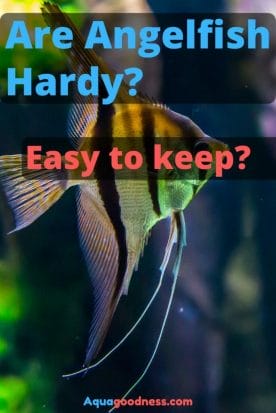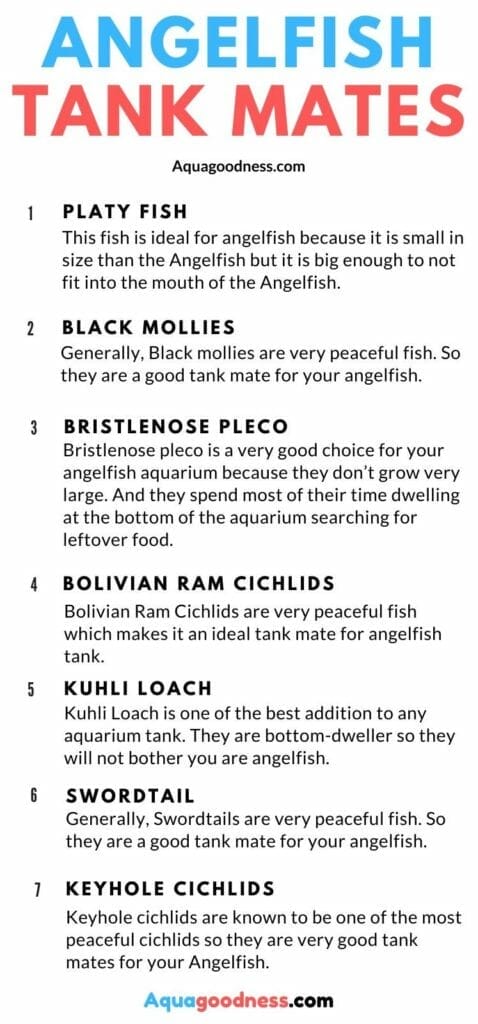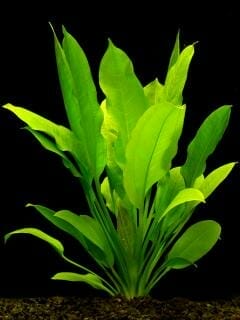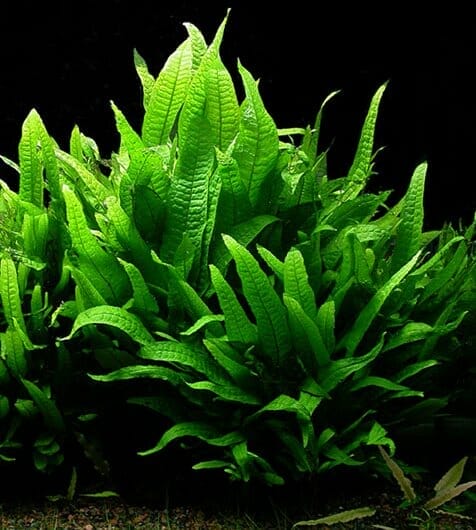Angelfish are one of the best aquarium fish. They look amazing. But, at the same time, they look very delicate.
So, are there really delicate? Or they are hardy?
This is what you are going to find out in this article.
Angelfish a relatively hardy. And they are easy to keep in your aquarium even if you are a beginner.
Once you add them in an established tank then you just have to maintain the ideal water parameters, keep up with feeding and they will do just fine.

Table of Contents
Are angelfish hard to keep?
Angelfish are not hard to keep. Domestic angelfish can tolerate a decent range of water parameters. So you can easily keep them in your aquarium.
Angelfish are susceptible to bacterial infections but you can easily solve this problem by having a good filtration system and doing water changes regularly.
Overall, if you maintain ideal water parameters, keep the water clean and feed the Angelfish well then they will do fine in your aquarium.
20 Tips to Maintain a Healthy Aquarium
Are angelfish good for beginners?
Yes, angelfish one of the recommended fish for beginners.
The best part about this fish is, it can tolerate a decent range of water parameters so you don’t have to worry too much about the water parameters like the pH and hardness of the water.
But angelfish are susceptible to diseases so there are a few things you should keep in mind to have a successful angelfish tank.
- The first thing is, you should keep angelfish in an established or cycled aquarium
- Angelfish prefer a tall tank. So you should keep them in a tall tank.
- Angelfish does well in warmer water so you should maintain temperature anywhere between 78 to 84 degrees Fahrenheit.
- The water current in the tank should be slow-moving.
- As angelfish can cause bacterial infection very easily, you should have a good filtration system in place.
- Also, you should do water changes regularly.
If you do the above things then you can easily keep angelfish in your tank even if you are a beginner.
15 Things You Must Know Before Buying Your First Aquarium
Angelfish Care
Now we are going to talk about how you can take care of your angelfish in your tank.
Well cycled tank
Angelfish are susceptible to bacterial infections so you should keep you should only keep them in a well-established tank i.e. in the tank in which the nitrogen cycle is completed and the ammonia and nitrate levels are zero.
Acclimating angelfish
Acclimating angelfish is one of the most important parts of the successful Angelfish tank.
If you messed up this part, it can even cause the death of your angelfish.
So you need to be very careful while acclimating angelfish before introducing it into your tank.
The steps for acclimating your angelfish are as follows:
- First, let the bag in which you brought the angelfish float on the surface of the water of your tank for 15 to 20 minutes.
- You should then start pouring down about a cup of water of your tank into the bag 2-3 times after every 30 minutes.
- Once the bag is fully filled with water then you should net out the angelfish and put it in the tank.
Maintaining the ideal water parameter range
To keep your angelfish stress-free, you should always maintain the ideal water parameter range for the Angelfish.
pH
The ideal pH range for angelfish is between 6 to 7.5 so you should maintain this range in your tank.
Temperature
Angelfish prefer warm water and its ideal temperature range is between 78 to 84 degrees Fahrenheit.
Hardness
Angelfish can tolerate a wide hardness range. That being said, the ideal hardness range for angelfish is between 5 to 13°DH.
Food
Angelfish diet is primarily a protein-rich diet.
In the wild, angelfish feed on small invertebrates, insects, larvae, and crustaceans.
So you should emulate the same in your fish tank and feed protein-rich food to your angelfish.
Live food
You can feed live food like bloodworms, brine shrimp, mysis shrimp to your angelfish.
It is the most nutritious and protein-rich food you can feed to your angelfish.
But live food also carries the risk of transferring harmful bacteria and parasites in your tank.
To avoid the risk, you should always get live food from a reputed store.
Also, you should feed the live food within 3-4 days.
Frozen food
Frozen food may not be as nutritious as live food but it is still very good food to feed to your angelfish.
It also has a very long storage life.
Before feeding frozen food just make sure to soak it into a small cup with the water of your fish tank for at least a couple of minutes and then feed it to your angelfish.
Flakes and pellets
Flakes and pellets are very affordable food you can feed to your angelfish.
But it is not as nutritious as frozen or live food like bloodworms, brine shrimp, etc.
But they are very convenient and you can easily find them in most of the aquarium shops.
While choosing flakes and pellets for angelfish, just make sure that it contains a high amount of protein.
Vegetables
You should also feed vegetables to your angelfish regularly.
You can feed them vegetables a couple of times a week.
Before feeding the vegetable make sure to boil it and cut it down into small pieces. So that it will be a lot easier for them to consume it.
How Long Do Angelfish Live For?
How much and how often should I feed to my angelfish?
The general rule of thumb to follow is to feed two to three times per day. And you should feed them the amount of food your angelfish can consume within 3 minutes.
How much and how often you should feed to your angelfish really depends on the size of your angelfish.
If you have baby angelfish then you should feed it more times per day, about three to four times per day.
But you should also be careful and do not overfeed them.
You should feed them are very little amount of food every time.
Baby angelfish can eat anything from frozen or dried bloodworms, baby brine shrimp, and pellets.
To big angelfish, you can feed them about a couple of times a day.
Tank
Now we are going to talk about the ideal tank size for your angelfish. Also, how to take care of your tank to increase the longevity of your angelfish.
Choose tall tank
Angelfish can get very big about 6 to 8 inches long and 10 to 12 inches tall.
As they get taller then longer they prefer a tall tank.
Ideal tank size
The ideal tank size for angelfish depends on a few factors.
Plants
Plants can take a lot of space in your tank. So you can use a smaller tank if you are not going to put any plant in your tank than when you are going to put a lot of plants in your tank.
Water changes
Weekly water change is very important to keep the ammonia levels in control in your aquarium.
So if you are willing to do water change multiple times per week then you can put your Indian fish in a relatively small tank than if you are willing to do water change only once a week.
Filtration system
The filtration system is also one of the most important factors when it comes to the tank size for your angelfish.
If you have a powerful canister filter then you can keep your angelfish in a relatively small tank than when you have any other small filter like HOB filter etc.
Tankmates
What kind of tankmates and how many tankmates you want to put in your angelfish tank also comes into play while deciding the ideal tank size for your angelfish tank.
For example, if you want to put a lot of tankmates that are very messy i.e. they produce a lot of waste then you will need a bigger tank.
After reading all these things that come into play while deciding the ideal tank size for your angelfish, I know it may be very overwhelming especially if you are a beginner.
So the general rule of thumb advise you to follow is to get a 29-gallon tank for two angelfish.
Why a 29-gallon tank?
A 29-gallon tank is big enough to put plants into the tank.
When you use a 29-gallon tank for two angelfish you don’t need to do water changes multiple times per week. Doing water change once a week is sufficient.
Also, a 29-gallon tank allows you to put a few tank mates and plants with your angelfish.
Maintain ideal water parameters
Once you chose a fish tank for your angelfish, it is very important to maintain the ideal water parameters in your tank so that you are angelfish can live stress-free and for a long time.
The ideal water parameters for an angelfish tank are as follows
pH: 6 to 7.5
Temperature: 78° Fahrenheit to 84° Fahrenheit
Hardness: 5-13 DH
Tankmates
In this section, we are going to talk about everything you need to know about Angelfish tank mates.
What kind of fish can live with angelfish?
While choosing tank mates for angelfish you should keep in mind a few things.
- The first thing is angelfish have long fins so so you should avoid keeping fin-nipper fish like tiger barbs with your angelfish
- Another thing to keep in mind is that you should avoid keeping the fish that are smaller than the size of the mouth of your angelfish. If you choose smaller fish then Angelfish may eat them.
- Though angelfish belong to the cichlids family, they are relatively less aggressive. Generally, they live peacefully and they usually get aggressive during the breeding periods. So it is a good idea to keep other peaceful fish with your angelfish.
Best angelfish tankmates

Ideal tank size to keep tank mates with your angelfish
Just like while deciding the ideal tank size for your angelfish, there are several factors that come into play while deciding the ideal tank size to keep tank mates with your angelfish.
What kind of tank mates and how many tank mates you put with your angelfish affects the tank size for your angelfish.
For example, if you are going to keep some messy fish i.e. the fish that produces a lot of waste then it is a good idea to get a bigger tank so that you will not have to do water changes very frequently.
On the other hand, if you keep a few fish that are not messy i.e. they don’t produce a lot of waste then you can keep them all together in a relatively small tank.
Besides, there are a few other factors that come into play while deciding the ideal tank size.
Filtration system
If you have a very good filtration system in place i.e. if you have a powerful filter like a canister filter in your tank then you can keep more fish as tankmates for your angelfish in the tank without any worry.
Weekly water change
If you are willing to do weekly water change multiple times a week then you can keep a lot of tank mates with your angelfish in a relatively small tank.
Plants and ornaments
How many plants and ornaments you want to put in the tank will also affect the tank size.
Ideally, you should get at least a 29-gallon tank for your angelfish.
It will allow you to put several species of fish as tankmates with your angelfish.
In a 29 gallon tank, you can keep a small school of Harlequin rasboras of about 4-6, a small school of cherry barbs, a couple of bristlenose plecos, a few nerite snails and 2-3 corydoras as well.
If you choose a larger tank then you can put even more tankmates in your angelfish tank.
Are Angelfish Freshwater Or Saltwater?
Plants
The natural habitat of angelfish contains a lot of plants so it is a very good idea to emulate the same in your aquarium.
Besides, there are a lot of benefits of keeping live plants in the aquarium.
They help oxygenate the tank.
Plants use ammonia in the tank as fertilizers so so they also help to reduce ammonia levels in your tank.
What plants do Angelfish like?
Angelfish generally like tall-growing aquarium plants with long and wide leaves like Amazon sword, Vallisneria, etc.
Angelfish require a vertical surface to lay their eggs on and plant leaves provide a very good vertical surface to lay their eggs.
So if you are planning to breed your angelfish then you should definitely keep some aquarium plants in your tank.
Ideal plants for angelfish tank
Now let’s talk about a few aquarium plants that are a good fit for an angelfish tank.
Amazon sword

| PARAMETERS | VALUES |
|---|---|
| PLANT | Amazon sword |
| SCIENTIFIC NAME | Echinodorus grisebachii |
| FAMILY | Alismataceae |
| CARE LEVEL | Easy |
| LIGHT REQUIREMENT | Moderate |
| GROWTH RATE | Fast |
| TEMPERATURE | 60.8-82.4°F |
| pH | 6.5-7.5 pH |
| HARDNESS | 8-15°dH |
| PLACEMENT | Background |
| MAXIMUM SIZE | 16 Inches |
| MINIMUM TANK SIZE | 10 Gallons |
Amazon sword is one of the most popular plants in the aquarium hobby.
It is the tall-growing stem plant that can grow as tall as 16 inches.
This plant has large white leaves so it is a good choice to keep in an Angelfish tank
If you are trying to breed angelfish then this is one of the best plants you can keep in the tank.
It will provide a lot of verticle surface area to lay the eggs to your angelfish.
Besides, it is a very hardy plant and can tolerate a wide range of water parameters so it is very easy to care and maintain.
You can use any substrate of your choice to plant amazon sword in your aquarium whether that is sand or gravel.
Just make sure that the substrate is at least 2.5 inches thick.
Java fern

| PARAMETERS | VALUES |
|---|---|
| PLANT | Java Fern |
| COMMON NAMES | Java Fern |
| SCIENTIFIC NAME | Microsorum pteropus |
| FAMILY | Polypodiaceae |
| CARE LEVEL | Easy |
| LIGHT REQUIREMENT | Low to Moderate |
| GROWTH RATE | Low to Moderate |
| TEMPERATURE | 68-82oF |
| pH | 6.0-7.5 |
| HARDNESS | 60-160 ppm |
| PLACEMENT | Mid to Background |
| MAXIMUM SIZE | 13.5 inches |
| MINIMUM TANK SIZE | 5 Gallons |
Java fern is another popular plant in the aquarium hobby.
It is also a tall growing plant with wide leaves which makes it an ideal choice to keep in the Angelfish tank.
This plant is also very cheap and can tolerate a decent range of water parameters which makes it an ideal choice for beginners.
It is a very hardy plant and can do well without any fertilizers.
Jungle Vallisneria
| PARAMETERS | VALUES |
|---|---|
| PLANT | Jungle Vallisneria |
| COMMON NAMES | Jungle Val, water celery, tape grass or eelgrass |
| SCIENTIFIC NAME | Vallisneria Americana |
| FAMILY | Hydrocharitaceae |
| CARE LEVEL | Intermediate |
| LIGHT REQUIREMENT | Medium |
| GROWTH RATE | Fast |
| TEMPERATURE | 65° – 85° F |
| pH | 6.8 – 8.0 |
| HARDNESS | Moderately Hard to Very Hard |
| PLACEMENT | Background |
| MAXIMUM SIZE | 6 feet (2 meters) |
| MINIMUM TANK SIZE | 10 gallon |
Jungle Vallisneria is a fast growing aquarium plant.
This plant can grow as tall as 6 feet.
And it can tolerate a wide range of water parameters which makes it an ideal choice for beginners.
Hornwort
| PARAMETERS | VALUES |
|---|---|
| PLANT | Hornwort |
| SCIENTIFIC NAME | Anthocerotophyta |
| CARE LEVEL | Easy |
| LIGHT REQUIREMENT | Medium |
| GROWTH RATE | Fast |
| TEMPERATURE | 59-86°F |
| pH | 6.0-7.5 |
| HARDNESS | 5-15 dGH |
| PLACEMENT | Background |
| MAXIMUM SIZE | 10 foot |
| MINIMUM TANK SIZE | 15 gallons |
Hornwort is a very hardy plant and can tolerate a wide range of water parameters so it is a good choice for beginners.
This plant can grow as long as 10 feet it is a good choice for an angelfish tank.
The best part about hornwort is that there are several ways you can keep it in your aquarium.
You can either plant it into the substrate like gravel or you can tie it to any ornament in your tank. Or you can just let it float in your aquarium.
6 Tips to Take Care of Live Plants in Aquarium (For Beginners)
Conclusion
Angelfish are relatively hardy and can tolerate a decent range of water parameters.
You can keep this fish even if you are a beginner.
Angelfish are very prone to diseases so you should maintain healthy water quality in your tank.
If you just do that you can easily keep it successfully in your aquarium.